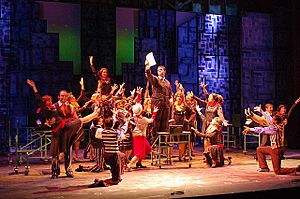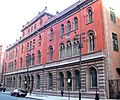Musical theater facts for kids
Musical theater is a type of show that brings together music, singing, dancing, and acting. It's like a live movie where a story unfolds through songs and dance moves. Imagine a play where characters don't just talk, but also sing their feelings and dance their way through adventures! It's a special mix of different art forms working together to create something amazing.
Contents
The Exciting History of Musicals
Musical theater has a long and interesting past, drawing ideas from many different cultures and traditions. Early forms of musical shows can be found in ancient Greece, where plays included music and group singing. But the musicals we enjoy today really started to grow in the late 1800s and early 1900s.
How Did Musicals Begin?
- Operetta (Late 1800s): These were popular in Europe. Operettas mixed spoken lines with singing, often telling fun and romantic stories. Think of them as the great-grandparents of modern musicals! Famous writers like W. S. Gilbert and Arthur Sullivan created popular operettas. Their shows, like "The Pirates of Penzance" (1879) and "The Mikado" (1885), are still performed today. They often had clever lyrics and catchy tunes.
- Early American Musicals (Early 1900s): The United States also developed its own style of musical theater. Early American musicals often used parts of vaudeville. Vaudeville was a type of variety show with singers, dancers, and comedians. These early shows focused more on showing off individual performers' talents than on a deep story. "Show Boat" (1927) is seen as a very important musical from this time.
The Golden Age of Broadway Musicals (1940s-1960s)
Musicals became super popular during this time. Many famous shows first appeared on Broadway. Writers like Richard Rodgers and Oscar Hammerstein II created amazing musicals. These include "Oklahoma!" (1943), "Carousel" (1945), "South Pacific" (1949), and "The Sound of Music" (1959). These musicals were known for their beautiful music and exciting stories. They often explored themes like love and hope. Dance also became a very important part of these shows.
New Ideas in Musicals (1960s-1970s)
A new type of musical, called the "concept musical," appeared. These shows focused more on exploring a big idea or theme rather than just a simple plot. "Hair" (1967) and "Company" (1970) are examples. They tried new ways of telling stories and often dealt with current social topics.
Mega-Musicals: Big Shows, Big Spectacle (1980s-Today)
From the late 1900s into today, "mega-musicals" became popular. These are huge shows with amazing sets, detailed costumes, and cool special effects. "Cats" (1981), "Les Misérables" (1985), and "The Phantom of the Opera" (1986) are examples. These musicals became huge hits worldwide. They often had large casts and complex stories, thrilling audiences with their grand scale and strong emotions.
Broadway: The Heart of Musical Theater
Broadway, located in New York City, is the most famous place for musical theater in the world. Many iconic musicals have started on Broadway. It's a very competitive and respected stage for performers and creators. A Broadway show usually runs for many months or even years. Millions of people come to see these shows. Winning a Tony Award, the top honor in Broadway theater, is a huge achievement for any musical.
Musicals Around the World
Musical theater isn't only found on Broadway. Many countries have their own lively musical theater scenes. They often have unique styles and traditions. London's West End is another major center for musicals, producing many successful shows. Other countries also have active musical theater communities. They create their own original works and adapt famous shows.
Famous Musicals You Should Know
Let's look at some popular musicals and their impact:
- The Sound of Music (1959): This beloved musical has been performed countless times. It has also been made into several movies. Its famous songs, like "My Favorite Things" and "Edelweiss," are known by many people.
- Hamilton (musical) (2015): This groundbreaking musical changed Broadway. It uses hip-hop music and features a diverse cast. It broke box office records and won many Tony Awards. Hamilton has had a big impact on showing different stories on stage.
- Wicked (musical) (2003): This musical tells a story before "The Wizard of Oz". It became a huge global hit. It has run for years on Broadway and toured all over the world. Its popularity shows how much people love new takes on classic stories.
- The Lion King (musical) (1997): This musical adaptation of the Disney film is visually stunning. It has amazed audiences worldwide. It uses creative puppetry and breathtaking staging to bring the story to life.
Images for kids
-
The Black Crook was a hit musical on Broadway in 1866.
-
A view of Rhodes by John Webb, painted for The Siege of Rhodes (1656)
-
Cover of the Vocal Score of Sidney Jones' The Geisha
-
Rodgers and Hammerstein (left and right) and Irving Berlin (center) at the St. James Theatre in 1948
-
Mary Martin starred in several Broadway hits of this era
-
Julie Andrews with Richard Burton in Camelot (1960)
-
Leonard Bernstein, 1971
-
Bernadette Peters (shown in 2008) has starred in five Sondheim musicals
-
A Chorus Line was one of 55 productions that Joseph Papp's Public Theatre brought to Broadway
-
The cast of Hamilton meets President Obama in 2015
-
Zac Efron and Zendaya (pictured), along with Hugh Jackman, brought star power to The Greatest Showman
-
Dove Cameron has starred in such TV musicals as Descendants, Hairspray Live! and Schmigadoon!
-
Marquee of the In the Heart of the Beast Theatre in Minneapolis, Minnesota, during the COVID-19 pandemic
-
The Lion King on Broadway
See also
 In Spanish: Musical para niños
In Spanish: Musical para niños


























